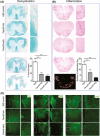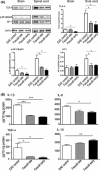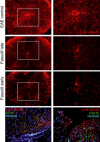Fasudil ameliorates disease progression in experimental autoimmune encephalomyelitis, acting possibly through antiinflammatory effect
- PMID: 22994384
- PMCID: PMC6493591
- DOI: 10.1111/cns.12002
Fasudil ameliorates disease progression in experimental autoimmune encephalomyelitis, acting possibly through antiinflammatory effect
Abstract
Aim: The purpose of this investigation was to further explore the mechanism(s) underlying the amelioration in EAE caused by Fasudil, particularly focusing on anti-inflammatory effect.
Methods: We induced a chronic-progressive experimental autoimmune encephalomyelitis (EAE) in B6 mice immunized with myelin oligodendrocyte glycoprotein(35-55) and performed Fasudil intervention in early and late stages of the disease.
Results: The administration of Fasudil (40 mg/kg, i.p) had a therapeutic effect in delaying the onset and ameliorating the severity of EAE, accompanied by the improvement in myelination and the decrease in inflammatory cells in spinal cords. Fasudil inhibited TLR-4, p-NF-kB/p65, and inflammatory cytokines (IL-1β, IL-6, and TNF-α) and enhanced IL-10 production in spinal cords. The ratio of arginase/iNOS was enhanced mainly in the spinal cords of EAE mice treated with Fasudil, reflecting a shift toward the M2 (antiinflammation) macrophage/microglia phenotype. The administration of Fasudil also induced the upregulation of CB2 receptor in spinal cords, but did not significantly trigger CB1 receptor. Levels of neurotrophic factors NGF, BDNF, and GDNF in the CNS were not altered by Fasudil.
Conclusion: Fasudil ameliorates disease progression in EAE, acting possibly through antiinflammatory pathway.
© 2012 Blackwell Publishing Ltd.
Conflict of interest statement
The authors declare no conflict of interest.
Figures






Similar articles
-
Changes of synapses in experimental autoimmune encephalomyelitis by using Fasudil.Wound Repair Regen. 2016 Mar;24(2):317-27. doi: 10.1111/wrr.12407. Epub 2016 Mar 2. Wound Repair Regen. 2016. PMID: 26789651
-
Targeting the shift from M1 to M2 macrophages in experimental autoimmune encephalomyelitis mice treated with fasudil.PLoS One. 2013;8(2):e54841. doi: 10.1371/journal.pone.0054841. Epub 2013 Feb 13. PLoS One. 2013. PMID: 23418431 Free PMC article.
-
Fasudil regulates T cell responses through polarization of BV-2 cells in mice experimental autoimmune encephalomyelitis.Acta Pharmacol Sin. 2014 Nov;35(11):1428-38. doi: 10.1038/aps.2014.68. Epub 2014 Sep 29. Acta Pharmacol Sin. 2014. PMID: 25263338 Free PMC article.
-
Nasal delivery of Fasudil-modified immune cells exhibits therapeutic potential in experimental autoimmune encephalomyelitis.CNS Neurosci Ther. 2019 Jun;25(6):783-795. doi: 10.1111/cns.13111. Epub 2019 Feb 18. CNS Neurosci Ther. 2019. PMID: 30779332 Free PMC article.
-
Therapeutic potentials of the Rho kinase inhibitor Fasudil in experimental autoimmune encephalomyelitis and the related mechanisms.Metab Brain Dis. 2019 Apr;34(2):377-384. doi: 10.1007/s11011-018-0355-7. Epub 2018 Dec 14. Metab Brain Dis. 2019. PMID: 30552558 Review.
Cited by
-
Toll-Like Receptor 4: A Promising Therapeutic Target for Alzheimer's Disease.Mediators Inflamm. 2022 Aug 21;2022:7924199. doi: 10.1155/2022/7924199. eCollection 2022. Mediators Inflamm. 2022. PMID: 36046763 Free PMC article. Review.
-
Fasudil Enhances Therapeutic Efficacy of Neural Stem Cells in the Mouse Model of MPTP-Induced Parkinson's Disease.Mol Neurobiol. 2017 Sep;54(7):5400-5413. doi: 10.1007/s12035-016-0027-8. Epub 2016 Sep 2. Mol Neurobiol. 2017. PMID: 27590141
-
Activating cannabinoid receptor 2 alleviates pathogenesis of experimental autoimmune encephalomyelitis via activation of autophagy and inhibiting NLRP3 inflammasome.CNS Neurosci Ther. 2014 Dec;20(12):1021-8. doi: 10.1111/cns.12349. CNS Neurosci Ther. 2014. PMID: 25417929 Free PMC article.
-
Macrophage Plasticity and Polarization Are Altered in the Experimental Model of Multiple Sclerosis.Biomolecules. 2021 Jun 4;11(6):837. doi: 10.3390/biom11060837. Biomolecules. 2021. PMID: 34200023 Free PMC article.
-
Reg-2, A Downstream Signaling Protein in the Ciliary Neurotrophic Factor Survival Pathway, Alleviates Experimental Autoimmune Encephalomyelitis.Front Neuroanat. 2016 May 9;10:50. doi: 10.3389/fnana.2016.00050. eCollection 2016. Front Neuroanat. 2016. PMID: 27242448 Free PMC article.
References
-
- Tselis A. Evidence for viral etiology of multiple sclerosis. Semin Neurol 2011;31:307–316. - PubMed
-
- Stadelmann C, Wegner C, Brück W. Inflammation, demyelination, and degeneration – recent insights from MS pathology. Biochim Biophys Acta 2011;1812:275–282. - PubMed
-
- Tuohy VK, Yu M, Yin L, et al. The epitope spreading cascade during progression of experimental autoimmune encephalomyelitis and multiple sclerosis. Immunol Rev 1998;164:93–100. - PubMed
-
- Sospedra M, Martin R. Immunology of multiple sclerosis. Annu Rev Immunol 2005;23:683–747. - PubMed
Publication types
MeSH terms
Substances
LinkOut - more resources
Full Text Sources
Other Literature Sources

